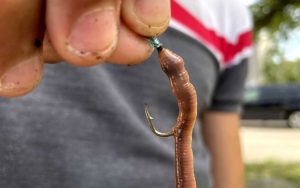When it comes to live bait, few options are as effective as worms. Whether targeting panfish, bass, or catfish, worms are versatile, easy to find, and irresistible to many species. However, properly baiting a hook with a worm can significantly impact the success of a fishing trip. Understanding the best techniques for rigging worms will lead to more bites, better hooksets, and a more rewarding day on the water.
1. Choosing the Right Worm
Before discussing technique, it’s essential to select the appropriate type of worm for the fish being targeted.
- Nightcrawlers: Perfect for larger species like bass or catfish, nightcrawlers are a popular choice because of their size and durability.
- Red Wigglers: Often used for panfish or trout, red wigglers are smaller but still effective in attracting fish.
- Mealworms: Typically used as a backup option, mealworms work well in clear water or when targeting smaller fish.
2. Basic Hook Baiting Techniques
Baiting a hook with a worm might seem simple, but a few different techniques can improve the chances of landing a catch. Here’s how to use worms effectively for different types of fishing:
- Threading the Worm: For larger worms like nightcrawlers, threading the worm onto the hook works well. Start by piercing the worm through its head and sliding it up the hook until most of the worm’s body covers the hook. This method hides the hook and prevents the worm from slipping off easily.
- Wacky Rig: A common technique when fishing for panfish or trout is the wacky rig. Simply hook the worm through the middle of its body, allowing both ends to dangle freely. This creates a lifelike movement in the water that entices fish to strike.
- Cut Worms: When fishing for smaller species or in areas with light-biting fish, consider cutting the worm into smaller sections. Using smaller pieces of worm can still attract bites while conserving bait.

3. Maximizing Presentation
The way a worm is presented in the water plays a significant role in how fish react to it. Here are a few tips for making a worm more enticing:
- Natural Movement: Avoid using too much weight on the line, as this can prevent the worm from moving naturally in the water. A lightly weighted rig or even a weightless setup allows the worm to drift and wriggle freely, mimicking its natural behavior.
- Floating Bait: Using floating rigs can help present the worm higher in the water column, making it more visible to fish. This technique is particularly useful when fishing in weedy or rocky areas where the worm might otherwise sink into cover.
4. Proper Hook Size
Matching the hook size to the worm and target fish species is crucial. Too large a hook might scare away smaller fish, while too small a hook can make it harder to land larger species.
- For Nightcrawlers: Use size 2-4 hooks for larger species like bass or catfish.
- For Red Wigglers or Mealworms: Smaller hooks, such as size 6-10, work best for trout, panfish, or smaller bass.
5. Bait Longevity
Worms can sometimes slide off the hook or be nibbled away by smaller fish before a solid bite. To make the bait last longer:
- Bait Elastic: Wrapping the worm with a fine bait elastic can help it stay on the hook longer, especially when fishing in fast-moving waters.
- Double Hooking: Piercing the worm in multiple spots (such as through the head and middle) can help secure it more firmly to the hook.
Mastering these techniques for baiting worms can turn an average fishing trip into a highly successful one. By paying attention to detail and properly rigging worms, anglers can significantly increase their chances of catching more fish.
Image: rapturefishing





